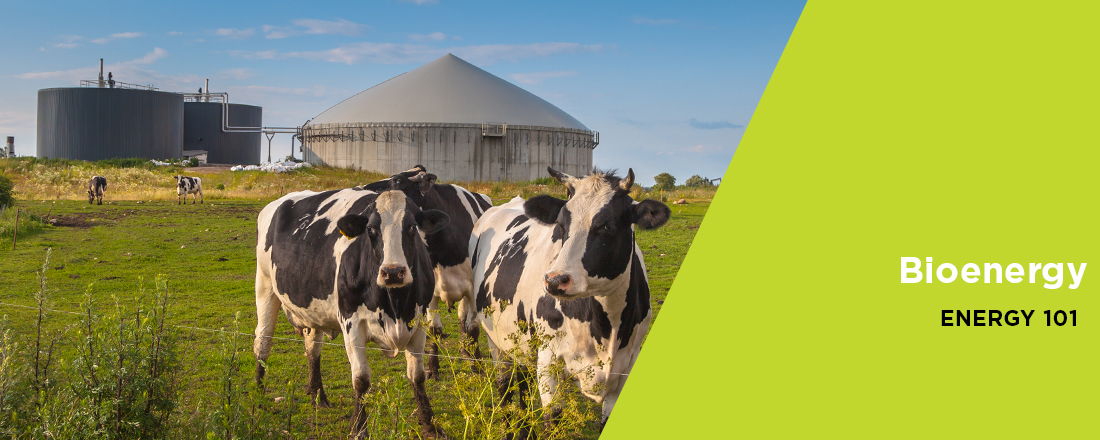MCE’s Energy 101 Series focuses on the why and how of renewable energy so that you can learn more about concepts like the benefits of biomass and the science behind solar. Looking for more? Check out the links in this blog to read more about Energy 101 or to dive deeper into our Energy Expert series.
Humans have been using bioenergy, or biomass, as an energy source since the invention of wood-burning fires. While the ways we use biomass resources have changed, biomass is a major global energy source. In this blog, we break down the basics of how biomass is harnessed and turned into renewable energy.
What is bioenergy?
Bioenergy is the process of turning organic matter, known as biomass, created by plants or animals into energy. Plants photosynthesize to convert the power of the sun into nutrients that they can use to grow. Biomass is the resulting waste from plant matter or animal waste that contains stored energy from the sun. Today we use biomass in the form of wood, crop waste, animal waste, and even garbage.
MCE’s Redwood Landfill Gas-to-Energy Project
What are the benefits of bioenergy?
Waste produced in the agricultural and forestry industries is often disposed of in landfills or by burning or composting. By using these resources to create bioenergy, we reduce greenhouse gas emissions, divert waste from landfills, and create additional revenue sources. Biomass is a renewable resource because it’s abundant and regenerates quickly. With responsible management, bioenergy can be carbon neutral. This means that, even though carbon is released into the atmosphere when biomass is converted into energy, the process of creating biomass pulls the same amount of carbon out of the atmosphere. This process creates a sustainable loop of growth and use.
What are the disadvantages of bioenergy?
The primary method of converting biomass into energy is through burning, which releases gases that can contribute to air pollution. If biomass resources were to be grown primarily for use in bioenergy, we would have to maintain large amounts of land and water. Additionally, it’s still expensive to build and operate biomass power plants. As biomass technology improves and the cost of creating facilities decreases, it’s important to implement sustainable practices that consider the entire supply chain. That way, we can ensure responsible use of resources when creating bioenergy.
How do we harness bioenergy?
Direct Combustion
Direct combustion is the process of burning biomass in a combustor or furnace that releases energy in the form of heat. This heat is used to create steam to power a turbine, which generates mechanical energy that’s converted into electricity. Direct combustion can also be used for space and water heating in buildings.
Anaerobic Digestion
The decomposition of biomass releases methane and carbon dioxide gas. In the process of anaerobic digestion, biomass from manure, food waste, and other organic materials is placed in an airtight container without oxygen. Once contained, this biomass is broken down by bacteria, which create gas as a by-product. This gas is then collected and used as a renewable alternative to natural gas.
Fuel Conversion
Biomass can also be converted into biofuels that act as a fossil fuel alternative. Biomass mass can be turned into fuel through thermochemical conversion, chemical conversion, or biological conversion. Thermochemical conversion uses heat to create fuel in a pressurized container. This fuel can be solid, liquid, or gas depending on the exact process. Chemical conversion uses chemicals to create liquid fuel, typically in the form of biodiesel. Biological conversion is the fermentation of biomass into ethanol, which is commonly used for transportation fuels.
Can bioenergy be used for transportation?
Liquid biofuels can be used in vehicles as an alternative to gasoline. The most common liquid biofuels are ethanol, made from sugars in grains, and biodiesel, made from natural oils. Both fuels provide cleaner alternatives to gasoline and diesel fuel. These alternative fuels are often mixed with traditional fuel sources. In fact, 97% of all gasoline in the United States contains some ethanol. Most gasoline is mixed with 10% ethanol, but flexible fuel vehicles can run on up to 83% ethanol fuel.
Looking for more Energy 101 blogs? Sign up for our monthly eNewsletter to get this content and more delivered straight to your inbox.






